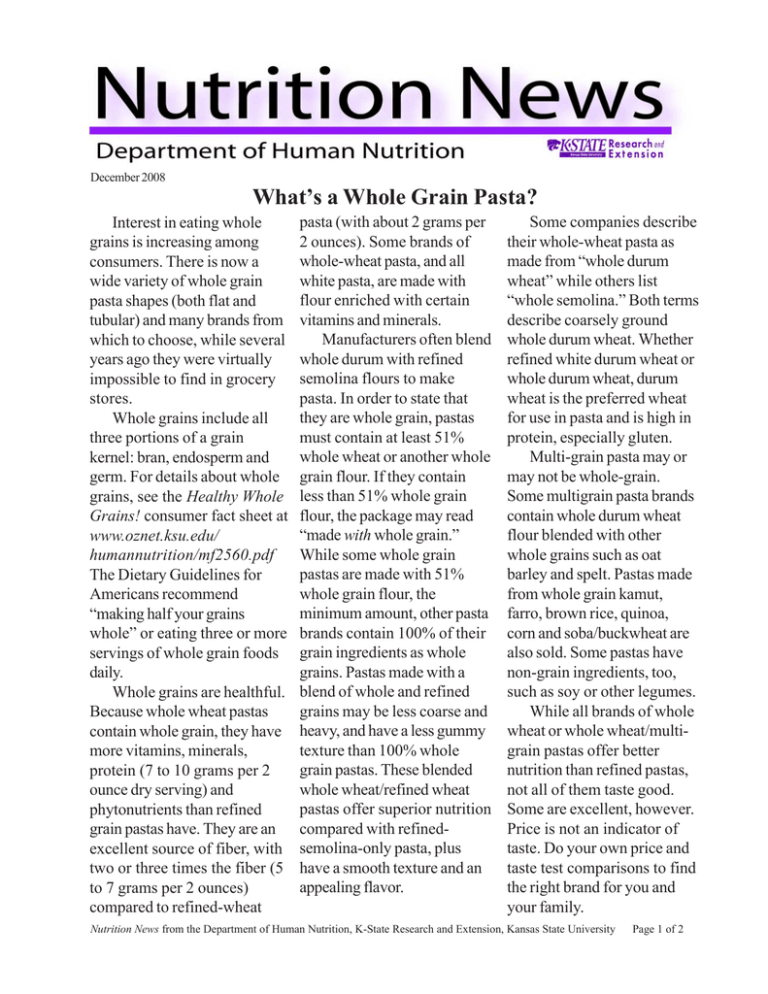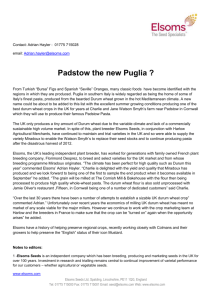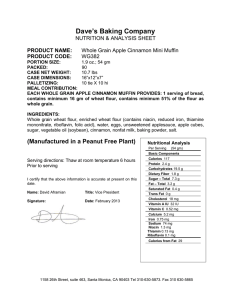What’s a Whole Grain Pasta?
advertisement

December 2008 What’s a Whole Grain Pasta? Interest in eating whole grains is increasing among consumers. There is now a wide variety of whole grain pasta shapes (both flat and tubular) and many brands from which to choose, while several years ago they were virtually impossible to find in grocery stores. Whole grains include all three portions of a grain kernel: bran, endosperm and germ. For details about whole grains, see the Healthy Whole Grains! consumer fact sheet at www.oznet.ksu.edu/ humannutrition/mf2560.pdf The Dietary Guidelines for Americans recommend “making half your grains whole” or eating three or more servings of whole grain foods daily. Whole grains are healthful. Because whole wheat pastas contain whole grain, they have more vitamins, minerals, protein (7 to 10 grams per 2 ounce dry serving) and phytonutrients than refined grain pastas have. They are an excellent source of fiber, with two or three times the fiber (5 to 7 grams per 2 ounces) compared to refined-wheat pasta (with about 2 grams per 2 ounces). Some brands of whole-wheat pasta, and all white pasta, are made with flour enriched with certain vitamins and minerals. Manufacturers often blend whole durum with refined semolina flours to make pasta. In order to state that they are whole grain, pastas must contain at least 51% whole wheat or another whole grain flour. If they contain less than 51% whole grain flour, the package may read “made with whole grain.” While some whole grain pastas are made with 51% whole grain flour, the minimum amount, other pasta brands contain 100% of their grain ingredients as whole grains. Pastas made with a blend of whole and refined grains may be less coarse and heavy, and have a less gummy texture than 100% whole grain pastas. These blended whole wheat/refined wheat pastas offer superior nutrition compared with refinedsemolina-only pasta, plus have a smooth texture and an appealing flavor. Some companies describe their whole-wheat pasta as made from “whole durum wheat” while others list “whole semolina.” Both terms describe coarsely ground whole durum wheat. Whether refined white durum wheat or whole durum wheat, durum wheat is the preferred wheat for use in pasta and is high in protein, especially gluten. Multi-grain pasta may or may not be whole-grain. Some multigrain pasta brands contain whole durum wheat flour blended with other whole grains such as oat barley and spelt. Pastas made from whole grain kamut, farro, brown rice, quinoa, corn and soba/buckwheat are also sold. Some pastas have non-grain ingredients, too, such as soy or other legumes. While all brands of whole wheat or whole wheat/multigrain pastas offer better nutrition than refined pastas, not all of them taste good. Some are excellent, however. Price is not an indicator of taste. Do your own price and taste test comparisons to find the right brand for you and your family. Nutrition News from the Department of Human Nutrition, K-State Research and Extension, Kansas State University Page 1 of 2 Nutrition News from the Department of Human Nutrition, K-State Research and Extension, Kansas State University Page 2 of 2 For more information about healthy eating, contact your local extension office. The Food Assistance Program can help people of all ages with low income buy nutritious foods for a better diet. To find out more, call toll-free 1-888-369-4777. Contents of this publication may be freely reproduced for educational purposes. All other rights reserved. In each case, credit Mary Meck Higgins, Ph.D., R.D., L.D., CDE, Associate Professor, Department of Human Nutrition; Kansas State University; What’s a Whole Grain Pasta?; December 2008. K-State Research and Extension is a short name for the Kansas State University Agricultural Experiment Station and Cooperative Extension Service, a program designed to generate and distribute useful knowledge for the well-being of Kansans. Supported by county, state, federal and private funds, the program has county Extension offices, experiment fields, area Extension offices and regional research centers statewide. Its headquarters is on the K-State campus, Manhattan. This material was funded in part by USDA’s Food Stamp Program through a contract with Kansas Department of Social and Rehabilitation Services. Brand names appearing in this publication are for product identification purposes only. No endorsement is intended, nor is criticism implied of similar products not mentioned. Kansas State University is an equal opportunity provider and employer. Kansas State University Agricultural Experiment Station and Cooperative Extension Service, Manhattan, Kansas. Kansas State University, County Extension Councils, Extension Districts, and the U.S. Department of Agriculture cooperating.





